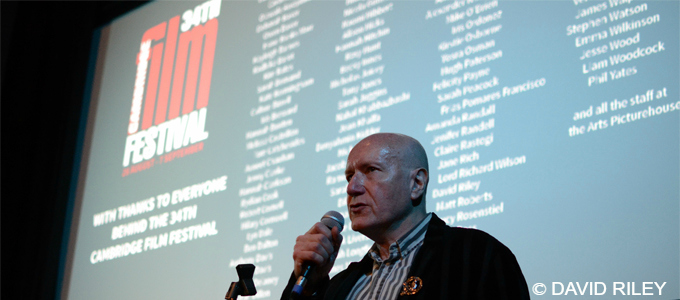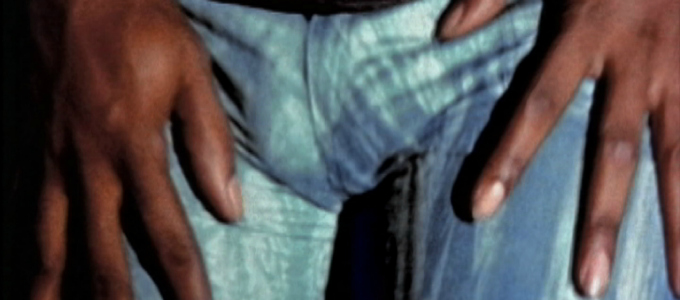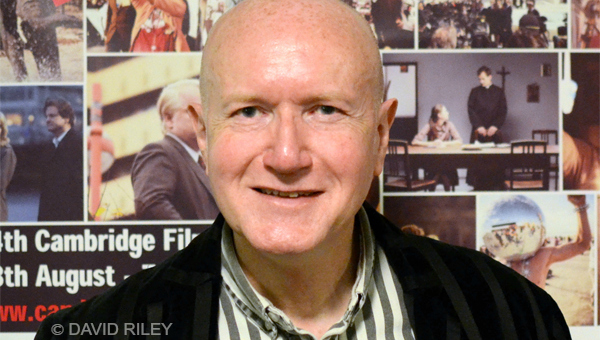 PETER DE ROME: GRANDFATHER OF GAY PORN documents the life and work of the infamous pioneer of gay erotic filmmaking. Comprising interviews with Peter De Rome himself as well as clips from his films, the documentary paints the invigorating and often hilarious portrait of a man dedicated to the joys of sex and the narrative of titillation. I sat down with David McGillivray, executive producer on the film, to discuss his own relationship with Peter’s work as well as his views on modern day pornography and tips on how to take pictures of your penis.
PETER DE ROME: GRANDFATHER OF GAY PORN documents the life and work of the infamous pioneer of gay erotic filmmaking. Comprising interviews with Peter De Rome himself as well as clips from his films, the documentary paints the invigorating and often hilarious portrait of a man dedicated to the joys of sex and the narrative of titillation. I sat down with David McGillivray, executive producer on the film, to discuss his own relationship with Peter’s work as well as his views on modern day pornography and tips on how to take pictures of your penis.
Ben Dalton: How did you get involved with the project?
DM: I first met Peter in 2007. The British Film Institute brought him over from New York to London’s National Film Theatre to introduce his short films. This was the first time that they’d ever been seen in the UK. Peter was completely unknown in this country, porn only having been legalized in 2000. I was fascinated by both his films and his life, and so I interviewed him and we stayed in touch. In 2012 BFI brought out THE EROTIC FILMS OF PETER DE ROME on DVD and asked whether I would like to write some notes for the DVD. I told them I’d rather make a film about him. I first went to New York and made “Fragments”, a featurette about some of the films he left unfinished, and there was so much material that I knew I had to make a longer version.
BD: This is a documentary about gay sex that seems to stay out of sexual politics. Whereas other LGBT films at the festival engage politically, like DANCING IN DULAIS and PRIDE, Peter De Rome’s seems to be more concerned with simply enjoying sex and having fun with sexuality. Was this a conscious decision?
DM: I think perhaps Peter is a bit ingenuous regarding gay politics. He always claimed he wasn’t interested at all and said that his only involvement was to watch the occasional Gay Pride. However he did testify for the Wolfenden committee and put himself on the line. We felt we couldn’t force him to say things he didn’t want to say and he really was adamant that he didn’t want to make statements himself in his films about what gay life should be. He was just having fun, as he kept saying. He loved making these films. For us it was most important to portray this sense of fun.
“You could never say – and this pun is utterly unintentional – that he was up his own arse.”
BD: There’s something quite utopian about Peter’s own sexuality as portrayed in the film. There doesn’t seem to have been any traumatic ‘coming out’ moment for him. He talks about making his way through the boys in his class at school, and experimenting widely with his sexuality from an early age without experiencing any sense of guilt or shame. Do you think to any extent he was attempting to create a utopian vision of what gay life could be?
DM: I wish I could say that Peter had some sort of agenda, but I really don’t think he did. Peter just didn’t conform to any gay stereotype. He also got involved with what might be considered today quite a politically incorrect lifestyle in that he began having sex very young. He was never part of any gay movement. As far as I’m concerned, all he wanted to do was have sex – that was very important to him – and to put some of his experiences having sex on screen. There is a lot of his material that isn’t shown in the documentary, and quite often he is up there on the screen having sex with the men that he has met on the street. He is an enormously present pioneer. You might even say that he pioneered the modern day type of “gonzo” porn-making. This is where filmmakers pretend to go up to people in the street and ask them whether they want to have sex, and then they go back to a hotel and film themselves having sex. Peter was doing this 50 or 60 years ago when absolutely no one else was.
BD: What was your first encounter with a Peter De Rome films? Have you got a favourite?
DM: I think the film I had heard most about was UNDERGROUND. It had a semi-legendary quality. Peter De Rome had gone onto the New York subway and actually filmed two guys having sex on a train. No one had ever attempted anything like this before and it really hasn’t been attempted again until quite recently. Peter is responsible for a lot of firsts in gay porn. As far as I’m concerned, Peter was the first to shoot a first-person cum shot in his film MUMBO JUMBO. I also thought he was the first person to shoot a no-hands cum shot. He revealed later that this had been a prosthetic, but no one had known! He carried on surprising all his life. I think his film ENCOUNTER also stands out. This is a film about men walking through New York with their arms stretched-out before all meeting together in a room. This is hugely popular amongst Peter De Rome fans.
BD: There’s a fascinating tension in Peter’s work between art and pornography. His DOUBLE EXPOSURE, for instance, has a real psychological element to it. This seems to have been completely lost from modern day pornography, would you agree?
DM: Totally. I think we’ve come through quite a terrible period in porn history where porn was of no interest altogether. It was nothing more than bumping and grinding. I think there are a few porn directors, although not many, who are now attempting to get back that narrative which I think is very important in porn and in the process of titillation. For Peter, as he says in his book, titillation is often more important than the act itself.
BD: There are a few recent film directors who have attempted to explore and blur the lines between art-house cinema and pornography like Catherine Breillat and Lars Von Trier for example. However, these directors don’t seem to go nearly as far as Peter De Rome did. Why do people make such a fuss about Von Trier and Breillat when their work is so less bold? Is the society we live in not much more open and willing than when De Rome was making films?
DM: I’m very glad you’ve said that. This is why it is so important to celebrate Peter’s work. There are very few who have done anything like what he did since. Some of the directors you mention, especially Breillat, have been criticized for being pretentious and you just can’t say that about Peter. Peter puts an enormous amount into his films because he had such a wide education and was so influenced himself by great masters of the cinema. You could never say – and this pun is utterly unintentional – that he was up his own arse.
BD: The way we watch porn nowadays is so different to in De Rome’s day. He talks a lot about screening his films at parties, and about there being a real social element to the enjoyment of pornography. Today porn seems to be such a solitary activity…
DM: There are good and bad sides to this. In the old days you could only watch pornography in the company of other people. Even in the case of soft porn, it was made almost entirely for men who had to go along to cinemas and sit as far apart from each other as they could because they wanted to masturbate under their raincoats. This wasn’t ideal. When video came about, it really was perfect for a lot of men. However, at the same time, everything that Peter talks about with regards to his parties sounds very social. Peter would come along with his projector and his tape recorder and there really was the sense of a major event. People were all watching something at the party that was very difficult to see. It is almost impossible nowadays to create a similar level of excitement when porn is available at the touch of a button.
BD: There is the cliché that whilst women are able to watch porn amongst other women in a relaxed, jovial setting, and maybe have a good laugh about it, the experience is very different for groups of men, in which things get quite tense. There is a great sense of humour to De Rome’s films – do you think this was all part of establishing pornography as a more social event?
DM: We are now getting into the interesting grounds of how men and women watch porn differently. What’s interesting about the two screenings we have had so far of the documentary is that audiences have been quite evenly spread, with 50% women and 50% men attending. This has come as a real surprise. Women do like, it would appear, Peter’s style of pornography. He was an artist, he had a sense of humour, and whilst I do not want to speak for women this does seem to appeal to a female audience. I very much doubt a lot of women would be aroused by the sort of porn popular among men which is just about bumping and grinding and “sticking it in”.
BD: This said, often with the “bump and grind” style porn that you talk about, there is often a narrative, but one that is self-consciously kitsch and two-dimensional. Whether it’s the plumber who has arrived to fix the pipes or the pizza boy with the “peperoni with extra sausage”, we see the same stories again and again. Why even bother?
DM: These are narratives that have become jokes because they’re clichés. To an extent I think men like that sense of knowing where they are with a scenario and being able to see where it’s going. I don’t think women are as comfortable with this unless it is used as a joke, or as post-modern irony. I have seen a few instances where this has been the case.
BD: Have you noticed much difference in the way that men and women react to the documentary? What about straight and gay reactions?
DM: As I said, it has been so unexpected to see such equal scores of men and women viewing the documentary and indeed to see so many straight men in the audience. One criticism we had from one female blogger is that there are no women in the film at all. I would have liked to have female perspectives in the film, but the way it was cut together just didn’t allow for this and I do regret that. Peter’s films are certainly very male orientated. To my knowledge he never actually put any women on screen. He did, however, include Madeleine Sherwood in the soundtrack of MUMBO JUMBO and Greta Garbo indeed makes a very brief appearance in the documentary. He was an old-style gay man in that he was obsessed with screen goddesses. Women in that sense were very important to him.
BD: How do you think masculinity has evolved since De Rome’s time? He mentioned in the documentary that a lot of the men he filmed were actually straight men who were experimenting with other men for the first time, or who were “gay for pay”. The masculine sexuality he portrays is very playful and open: is this spirit of experimentation still alive?
DM: As far as men in general are concerned, it seems to me that down the ages only the clothes and hairstyles change. In terms of gay desire, it still seems to be the case that gay men are still looking for masculine-looking men, men who do not look gay. With regards to the ways of having sex, something tells me that we will never go back to pre-AIDS gay sex. Few people have any conception of what gay sex was like prior to the 1980s. AIDS came as such a shock. Before that, it was nothing to have more than ten men on the same night. People would go to the clubs and the saunas in the early evening, pick up a man, and continue for the next 12 hours or so. It was like Dante’s gay inferno!
BD: A lot of people feel uncomfortable labelling their sexuality these days, choosing instead to embrace more fluid ways of thinking about desire. Is this a big change?
DM: Absolutely. I think nowadays “straight” men are a lot more questioning about their sexuality. It is no longer a big deal at all to have a couple of lagers and snog another bloke. It might not go all the way to full penetration, but I think the very notion of sexuality is now under consideration. Does snogging another man make you gay? I think there are a lot of grey areas that just weren’t there before. There is of course the Kinsey scale, and very few people can place themselves conclusively at one end or the other.
“in Cambridge, for example, think back to the nest of spies with Burgess and McClean – they were all at it!”
BD: In terms of the “lad culture” phenomenon, a huge part of the affirmation of heterosexuality seems to reside in “bromance” or in quite explicit gay role-play. What is going on here?
DM: I don’t think you can talk of “bromance” as a modern phenomenon. Here in Cambridge, for example, think back to the nest of spies with Burgess and McClean – they were all at it! This is cyclical I think. If you’re talking about university students, they have always been more gay-friendly than anyone else. With rugby culture as well, although I’m not suggesting they’re all having it off in the baths, but things are doubtlessly going to be quite homoerotic. This is why the rugby-scenario is such a big thing in gay culture!
BD: How do you see porn evolving into the future? Will it continue as a discrete art form, or will it become more hybrid?
DM: We are going through a very interesting period in the history of porn. It’s so readily available now and it’s free! Before this we have always had to pay for porn, and nowadays it’s not possible for pornographers to make a huge amount of money out of porn. They are going to have to find another way to make porn pay. Whatever happens, however, porn will always be with us. We have to have porn, we need it.
BD: I know people who have chosen to pay for good quality, high definition porn and then craved to return to the grainier, lower production stuff. Why is that?
DM: I think it is ingrained in people that porn is dirty and illegal, and that the only way men can enjoy it is if it looks that way. When porn is too slick and too polished, a lot of men don’t get the same kind of buzz out of it. Think of the recent leaking of the grainy Jennifer Lawrence photos for instance. These photos are barely even pornography, they are just of naked women, but the thrill generated comes from their being illegal. This is a thrill widely lost from modern erotica.
BD: De Rome talks a lot about the importance of titillation. When porn is all about genitals and full exposure, how do you retain that sense of mystery?
DM: Peter wasn’t that interested in the sex act itself. He was much more interested in clothes coming away from the body, being taken off. Of course he would show the genitals at the end, as you had to have the money shot. But I think especially in times of greater censorship, culture has always been about what can be suggested and excited by dressing and covering things up.
BD: Finally, what top tips have you learned from Peter De Rome that you can pass on? How do we make good porn?
DM: You have to be innovative. Be titillating – don’t put all your goods in the shop window. And thirdly, use interesting models. Do not use models that are trendy, as they will go out of style. Peter De Rome’s models are just as sexy now as they were back in the day.
BD: Nowadays everyone has a video phone or camera. Everyone can make porn. What did Peter De Rome think about this new accessibility to homemade erotica, and would he have any good advice for making your genitals look good on webcam?
DM: He actually didn’t like all that type of thing. It was much too upfront for him, and he didn’t like a lot of modern pornography. As far as genitalia is concerned, I’m pretty sure Peter only worked with men who had enormous penises so he never accounted the problem of having to enhance with particular camera angles. Please reassure all of your friends who are insecure about their penis size through watching porn that the only men who work in porn are those blessed with gigantic equipment. I think we’ll finish on that note.
httpvh://youtu.be/Wpw7l4tbaFM

